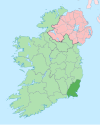Fethard-on-Sea
Fethard-on-Sea
Fiodh Ard | |
|---|---|
Village | |
 Fethard Quay | |
 Fethard-on-Sea Location in Ireland | |
| Coordinates: 52°11′42″N 6°49′59″W / 52.195°N 6.833°WCoordinates: 52°11′42″N 6°49′59″W / 52.195°N 6.833°W | |
| Country | Ireland |
| Province | Leinster |
| County | Wexford |
| Elevation | 15 m (49 ft) |
| Population (2016)[1] | |
| • Total | 311 |
| Irish Grid Reference | S793049 |
Fethard-on-Sea or Fethard (Irish: Fiodh Ard, meaning 'high wood')[2] is a village in southwest County Wexford in Ireland. It lies on the R734 road on the eastern side of the Hook peninsula, between Waterford Harbour and Bannow Bay.
The village had a population of 311 as of the 2016 census.[1] It lies in the Fethard electoral district in the Wexford constituency. It is in the Templetown parish in the Roman Catholic Diocese of Ferns. Its main industries are fishing and tourism.[citation needed]
Public transport[]
Two Bus Éireann routes serve Fethard-on-Sea: route 370 to Waterford via New Ross and a Tuesday-only route 373 to Wexford via Wellingtonbridge.[3]
History[]
In the 12th century, Baginbun near Fethard was the site of Norman landings during the Norman invasion of Ireland.[4][5] The remains of Norman-era earthworks and fortifications may be seen at Baginbun Bay, south of Ingard Point.[6]
A 12th-century castle was built by Raymond le Gros, which passed to the Bishop of Ferns and was used as an episcopal residence. There is little evidence of the castle today.[citation needed]
Alexander Devereux, the 16th-century bishop of Ferns and Abbot of Dunbrody, is buried in St. Mogue's Church of Ireland church.[5]
Fethard was granted a charter by James I of England,[5] and became a municipal borough, sending two members to the Irish parliament, before its dissolution.[citation needed] In 1798, a harbour,[5] was built and this was a landing site for French troops during the revolutionary wars.[citation needed]
Village name[]
Long known simply as 'Fethard', the village became known as Fethard-on-Sea following events in 1914 when the lifeboat Helen Blake capsized. Nine of the lifeboat's fourteen-man crew were drowned during a service mission to the schooner Mexico off the Keeragh Islands.[7] There was an outpouring of sympathy for the village and charitable donations were posted from around the world. To avoid this post from being misdirected to Fethard in County Tipperary, the name of the Fethard in County Wexford was reputedly changed to better distinguish the two.[7]
Local businesses[]
There are three public houses in the village, a grocery shop and a number of cafes, B&B and a hotel that was refurbished and reopened in 2019.[8] Local tourist attractions include Hook Head Lighthouse and Loftus Hall, further afield on the Hook Peninsula.
Fethard-on-Sea boycott[]
In May 1957, Roman Catholic villagers boycotted Protestant-owned local businesses in response to the actions of a Protestant woman, Sheila Cloney, who left her Catholic husband, and took her children away to avoid being forced to send them to the local Catholic school as the local Catholic priest demanded. The boycott received national and international attention before it concluded. The family was reconciled eventually, with the daughters being home-schooled.[9][10]
Film[]
A film was made about the Cloney family called (1999) starring Orla Brady as Sheila Cloney.[11] The film also proved to be controversial, with allegations of fabrications and historical misrepresentation,[12][13][14] and the omission of important facts relating to the case.[15][16] Press criticism focused on one of the film's writers, Gerry Gregg, a Communist and former member of the Workers' Party of Ireland,[17] who was accused of antagonism towards the Roman Catholic Church[18] and towards Irish Republicanism.[17]
See also[]
- Hook Head
- List of RNLI stations
- List of towns and villages in Ireland
- Mervyn A. Ellison
References[]
- ^ Jump up to: a b "Sapmap Area: Settlements Fethard-on-Sea". Census 2016. Central Statistics Office. 2016.
- ^ "Fiodh Ard / Fethard". logainm.ie. Placenames Database of Ireland. 18 January 2020.
- ^ "Regional Services by County". Bus Éireann. Retrieved 23 March 2020.
- ^ "Normans' Baginbun landing book release". wexfordpeople.ie. Wexford People. 27 May 2017. Retrieved 18 January 2020.
- ^ Jump up to: a b c d Samuel Lewis (1837). Topographical Dictionary of Ireland - Fethard – via libraryireland.com.
- ^ "Fethard-On-Sea". southeastireland.com. Archived from the original on 22 July 2005. Retrieved 20 September 2005.
- ^ Jump up to: a b "A terrible loss... an incredible story of survival". Gorey Guardian. Independent News & Media. 23 February 2019. Retrieved 18 January 2020.
- ^ "Fethard on fire!". independent. Retrieved 25 August 2020.
- ^ National Archives press clippings National Archives.
- ^ Love conquers all: but for decades a village paid the price Sunday Mirror, 1999-12-05.
- ^ A Love Divided Archived 2007-09-28 at the Wayback Machine
- ^ "LOVE CONQUERS ALL; But for decades a village paid the price of – Sunday Mirror – Find Articles at BNET.com". Archived from the original on 2 March 2011.
- ^ "Obituary: Sean Cloney – Independent, The (London) – Find Articles at BNET.com". Archived from the original on 8 March 2008.
- ^ National archives Finding aid: Women in 20th-Century Ireland, 1922–1966 (Browse records)
- ^ The Mayo News – Fethard boycott recalled
- ^ "Religion: Fethardism". Time. 19 August 1957. Archived from the original on 2 March 2011.
- ^ Jump up to: a b The return of the revisionists: ThePost.ie Archived 2008-04-10 at the Wayback Machine
- ^ Catholic League: For Religious and Civil Rights Archived 2008-05-10 at the Wayback Machine
- Towns and villages in County Wexford
- Roman Catholic Diocese of Ferns

